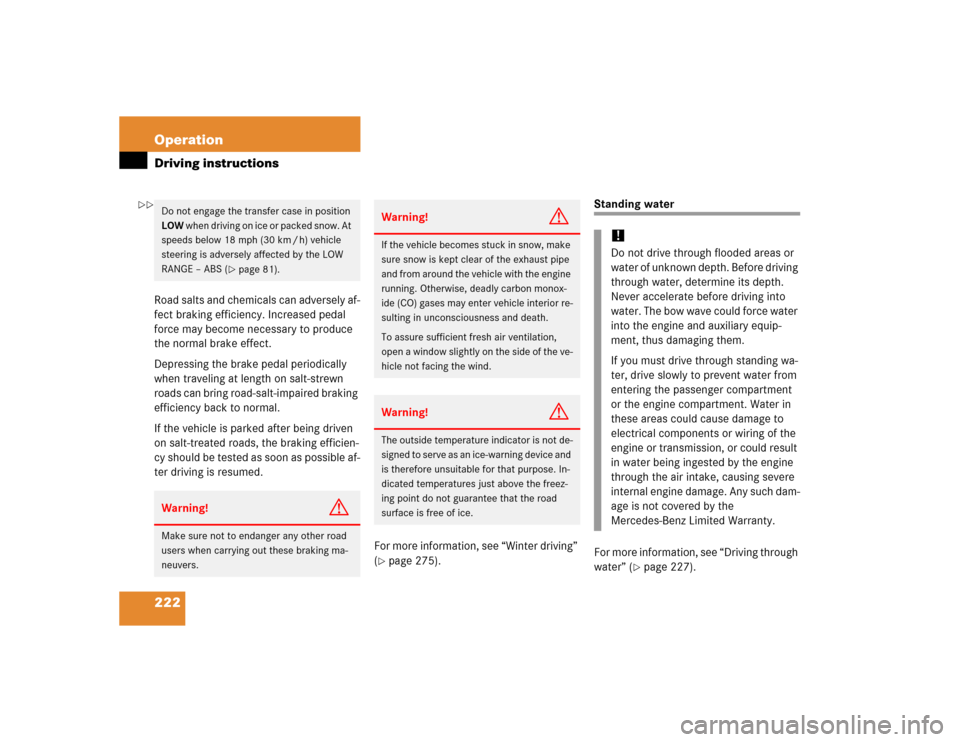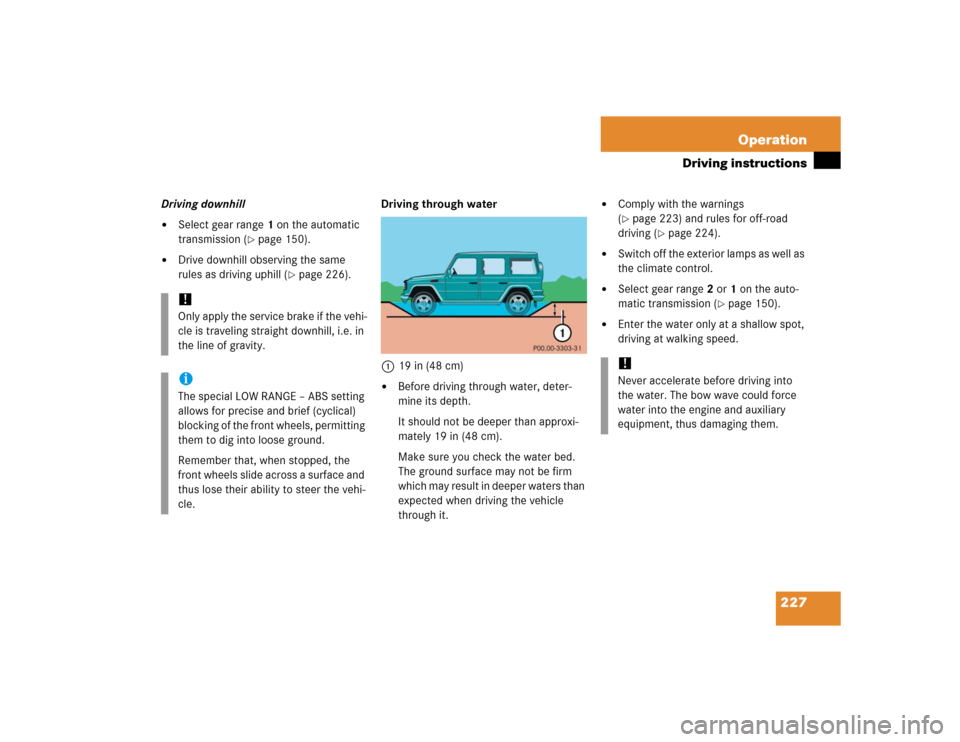Page 196 of 416
196 Controls in detailUseful featuresElectrical outletElectrical outlet in the rear passenger
footwell
Electrical outlet on the left side (driver’s
side) of the cargo compartment
�
Switch on the ignition (
�page 35).
�
Flip up cover and insert electrical plug
(cigarette lighter type).
Floormats
NN
iThe electrical outlet can be used to ac-
commodate electrical consumers (e.g.
air pump, auxiliary lamps) up to a max-
imum of 180 W.
Warning!
G
Whenever you are using floormats, make
sure there is enough clearance and the
floormats are securely fastened.
Floormats should always be securely fas-
tened using the eyelets and retainer pins.
Before driving off, check that the floormats
are securely in place and adjust them if nec-
essary. A loose floormat could slip and
hinder proper functioning of the pedals.
Page 222 of 416

222 OperationDriving instructionsRoad salts and chemicals can adversely af-
fect braking efficiency. Increased pedal
force may become necessary to produce
the normal brake effect.
Depressing the brake pedal periodically
when traveling at length on salt-strewn
roads can bring road-salt-impaired braking
efficiency back to normal.
If the vehicle is parked after being driven
on salt-treated roads, the braking efficien-
cy should be tested as soon as possible af-
ter driving is resumed.
For more information, see “Winter driving”
(
�page 275).
Standing water
For more information, see “Driving through
water” (
�page 227).
Do not engage the transfer case in position
LOW when driving on ice or packed snow. At
speeds below 18 mph (30 km / h) vehicle
steering is adversely affected by the LOW
RANGE – ABS (
�page 81).
Warning!
G
Make sure not to endanger any other road
users when carrying out these braking ma-
neuvers.
Warning!
G
If the vehicle becomes stuck in snow, make
sure snow is kept clear of the exhaust pipe
and from around the vehicle with the engine
running. Otherwise, deadly carbon monox-
ide (CO) gases may enter vehicle interior re-
sulting in unconsciousness and death.
To assure sufficient fresh air ventilation,
open a window slightly on the side of the ve-
hicle not facing the wind.Warning!
G
The outside temperature indicator is not de-
signed to serve as an ice-warning device and
is therefore unsuitable for that purpose. In-
dicated temperatures just above the freez-
ing point do not guarantee that the road
surface is free of ice.
!Do not drive through flooded areas or
water of unknown depth. Before driving
through water, determine its depth.
Never accelerate before driving into
water. The bow wave could force water
into the engine and auxiliary equip-
ment, thus damaging them.
If you must drive through standing wa-
ter, drive slowly to prevent water from
entering the passenger compartment
or the engine compartment. Water in
these areas could cause damage to
electrical components or wiring of the
engine or transmission, or could result
in water being ingested by the engine
through the air intake, causing severe
internal engine damage. Any such dam-
age is not covered by the
Mercedes-Benz Limited Warranty.
��
Page 227 of 416

227 Operation
Driving instructions
Driving downhill�
Select gear range1 on the automatic
transmission (
�page 150).
�
Drive downhill observing the same
rules as driving uphill (
�page 226).Driving through water
119 in (48 cm)
�
Before driving through water, deter-
mine its depth.
It should not be deeper than approxi-
mately 19 in (48 cm).
Make sure you check the water bed.
The ground surface may not be firm
which may result in deeper waters than
expected when driving the vehicle
through it.
�
Comply with the warnings
(�page 223) and rules for off-road
driving (
�page 224).
�
Switch off the exterior lamps as well as
the climate control.
�
Select gear range2 or1 on the auto-
matic transmission (
�page 150).
�
Enter the water only at a shallow spot,
driving at walking speed.
!Only apply the service brake if the vehi-
cle is traveling straight downhill, i.e. in
the line of gravity.iThe special LOW RANGE – ABS setting
allows for precise and brief (cyclical)
blocking of the front wheels, permitting
them to dig into loose ground.
Remember that, when stopped, the
front wheels slide across a surface and
thus lose their ability to steer the vehi-
cle.
!Never accelerate before driving into
the water. The bow wave could force
water into the engine and auxiliary
equipment, thus damaging them.